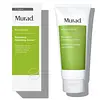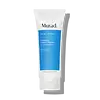What's inside
What's inside
 Key Ingredients
Key Ingredients

 Benefits
Benefits

 Concerns
Concerns

 Ingredients Side-by-side
Ingredients Side-by-side

Water
Skin ConditioningSodium Cocoyl Isethionate
CleansingGlyceryl Stearate Se
EmulsifyingGlycerin
HumectantStearic Acid
CleansingCetyl Alcohol
EmollientPrunus Armeniaca Kernel Oil
MaskingPalmitoyl Tripeptide-5
Skin ConditioningButyrospermum Parkii Butter Extract
Skin ConditioningCocamidopropyl Dimethylamine
EmulsifyingLactic Acid
BufferingHydrated Silica
AbrasivePhenylethyl Resorcinol
AntioxidantHydrolyzed Corn Starch
HumectantSodium Hydroxide
BufferingUrea
BufferingYeast Amino Acids
HumectantTrehalose
HumectantInositol
HumectantTaurine
BufferingBetaine
HumectantBorago Officinalis Seed Oil
EmollientOenothera Biennis Seed Extract
Skin ConditioningSerenoa Serrulata Fruit Extract
Skin ConditioningPanthenol
Skin ConditioningChondrus Crispus Extract
Skin ConditioningChamomilla Recutita Flower Extract
MaskingSodium Hyaluronate
HumectantImperata Cylindrica Root Extract
Skin ConditioningBenzophenone-4
UV AbsorberButylene Glycol
HumectantPEG-8
HumectantBenzalkonium Chloride
AntimicrobialCarbomer
Emulsion StabilisingXanthan Gum
EmulsifyingPhenoxyethanol
PreservativeCaprylyl Glycol
EmollientChlorphenesin
AntimicrobialParfum
MaskingWater, Sodium Cocoyl Isethionate, Glyceryl Stearate Se, Glycerin, Stearic Acid, Cetyl Alcohol, Prunus Armeniaca Kernel Oil, Palmitoyl Tripeptide-5, Butyrospermum Parkii Butter Extract, Cocamidopropyl Dimethylamine, Lactic Acid, Hydrated Silica, Phenylethyl Resorcinol, Hydrolyzed Corn Starch, Sodium Hydroxide, Urea, Yeast Amino Acids, Trehalose, Inositol, Taurine, Betaine, Borago Officinalis Seed Oil, Oenothera Biennis Seed Extract, Serenoa Serrulata Fruit Extract, Panthenol, Chondrus Crispus Extract, Chamomilla Recutita Flower Extract, Sodium Hyaluronate, Imperata Cylindrica Root Extract, Benzophenone-4, Butylene Glycol, PEG-8, Benzalkonium Chloride, Carbomer, Xanthan Gum, Phenoxyethanol, Caprylyl Glycol, Chlorphenesin, Parfum
Salicylic Acid 0.5%
MaskingWater
Skin ConditioningDisodium Cocoamphodiacetate
CleansingGlycerin
HumectantButylene Glycol
HumectantCetyl Alcohol
EmollientCocamidopropyl Betaine
CleansingPPG-15 Stearyl Ether
EmollientSodium Cocoyl Isethionate
CleansingGlyceryl Stearate
EmollientPEG-100 Stearate
Sodium Polyacrylate
AbsorbentSodium Hyaluronate
HumectantTocopheryl Acetate
AntioxidantCaprylic/Capric Triglyceride
MaskingRetinol
Skin ConditioningSalix Alba Bark Extract
AstringentAscorbic Acid
AntioxidantChitosan
Silver Citrate
AntimicrobialSodium PCA
HumectantBetaine
HumectantSorbitol
HumectantGlycine
BufferingAlanine
MaskingProline
Skin ConditioningSerine
MaskingThreonine
Arginine
MaskingLysine
Skin ConditioningGlutamic Acid
HumectantZinc Gluconate
Skin ConditioningArgania Spinosa Kernel Oil
EmollientSerenoa Serrulata Fruit Extract
Skin ConditioningSesamum Indicum Seed Oil
EmollientBeta-Sitosterol
Emulsion StabilisingCimicifuga Racemosa Root Extract
AntimicrobialMelaleuca Alternifolia Leaf Oil
AntioxidantCocamidopropyl Dimethylamine
EmulsifyingZea Mays Starch
AbsorbentHydrolyzed Corn Starch
HumectantHydrolyzed Corn Starch Octenylsuccinate
AbsorbentCitric Acid
BufferingDisodium EDTA
Propyl Gallate
AntioxidantPolysorbate 80
EmulsifyingMenthol
MaskingGlycol Distearate
EmollientSteareth-4
EmulsifyingPEG-150 Distearate
EmulsifyingPhenoxyethanol
PreservativeCaprylyl Glycol
EmollientChlorphenesin
AntimicrobialParfum
MaskingTea-Sulfate
BufferingSoy Protein Phthalate
EmollientGlutaral
PreservativeParaffinum Liquidum
EmollientFormaldehyde
Benzophenone-3
UV AbsorberPetrolatum
EmollientSalicylic Acid 0.5%, Water, Disodium Cocoamphodiacetate, Glycerin, Butylene Glycol, Cetyl Alcohol, Cocamidopropyl Betaine, PPG-15 Stearyl Ether, Sodium Cocoyl Isethionate, Glyceryl Stearate, PEG-100 Stearate, Sodium Polyacrylate, Sodium Hyaluronate, Tocopheryl Acetate, Caprylic/Capric Triglyceride, Retinol, Salix Alba Bark Extract, Ascorbic Acid, Chitosan, Silver Citrate, Sodium PCA, Betaine, Sorbitol, Glycine, Alanine, Proline, Serine, Threonine, Arginine, Lysine, Glutamic Acid, Zinc Gluconate, Argania Spinosa Kernel Oil, Serenoa Serrulata Fruit Extract, Sesamum Indicum Seed Oil, Beta-Sitosterol, Cimicifuga Racemosa Root Extract, Melaleuca Alternifolia Leaf Oil, Cocamidopropyl Dimethylamine, Zea Mays Starch, Hydrolyzed Corn Starch, Hydrolyzed Corn Starch Octenylsuccinate, Citric Acid, Disodium EDTA, Propyl Gallate, Polysorbate 80, Menthol, Glycol Distearate, Steareth-4, PEG-150 Distearate, Phenoxyethanol, Caprylyl Glycol, Chlorphenesin, Parfum, Tea-Sulfate, Soy Protein Phthalate, Glutaral, Paraffinum Liquidum, Formaldehyde, Benzophenone-3, Petrolatum
Alternatives
Ingredients Explained
These ingredients are found in both products.
Ingredients higher up in an ingredient list are typically present in a larger amount.
Betaine is a common humectant (a substance that promotes retention of moisture). It's known to be gentle on the skin and can help balance hydration.
This ingredient is best for improving hydration and soothing irritated skin. Studies also show it helps even out skin tone.
Fun fact: Betaine is naturally created in the skin and body. The kind found within cosmetic products can be either plant-derived or synthetic.
Another name for betaine is trimethylglycine.
Learn more about BetaineButylene Glycol (or BG) is used within cosmetic products for a few different reasons:
Overall, Butylene Glycol is a safe and well-rounded ingredient that works well with other ingredients.
Though this ingredient works well with most skin types, some people with sensitive skin may experience a reaction such as allergic rashes, closed comedones, or itchiness.
Learn more about Butylene GlycolCaprylyl Glycol is a humectant and emollient, meaning it attracts and preserves moisture.
It is a common ingredient in many products, especially those designed to hydrate skin. The primary benefits are retaining moisture, skin softening, and promoting a healthy skin barrier.
Though Caprylyl Glycol is an alcohol derived from fatty acids, it is not the kind that can dry out skin.
This ingredient is also used as a preservative to extend the life of products. It has slight antimicrobial properties.
Learn more about Caprylyl GlycolCetyl Alcohol is a fatty alcohol. Fatty Alcohols are most often used as an emollient or to thicken a product.
Its main roles are:
Though it has "alcohol" in the name, it is not related to denatured alcohol or ethyl alcohol.
The FDA allows products labeled "alcohol-free" to have fatty alcohols.
Learn more about Cetyl AlcoholChlorphenesin is a synthetic preservative. It helps protect a product against bacteria in order to extend shelf life. In most cases, Chlorphenesin is paired with other preservatives such as phenoxyethanol and caprylyl glycol.
Chlorphenesin is a biocide. This means it is able to help fight the microorganisms on our skin. It is also able to fight odor-releasing bacteria.
Chlorphenesin is soluble in both water and glycerin.
Studies show Chlorphenesin is easily absorbed by our skin. You should speak with a skincare professional if you have concerns about using Chlorphenesin.
Learn more about ChlorphenesinCocamidopropyl Dimethylamine comes from the fatty acids of coconut oil. It is an emulsifier, meaning it helps stabilize and mix ingredients.
This ingredient can be irritating in higher amounts and is related to Cocamidopropyl Betaine.
Glycerin is already naturally found in your skin. It helps moisturize and protect your skin.
A study from 2016 found glycerin to be more effective as a humectant than AHAs and hyaluronic acid.
As a humectant, it helps the skin stay hydrated by pulling moisture to your skin. The low molecular weight of glycerin allows it to pull moisture into the deeper layers of your skin.
Hydrated skin improves your skin barrier; Your skin barrier helps protect against irritants and bacteria.
Glycerin has also been found to have antimicrobial and antiviral properties. Due to these properties, glycerin is often used in wound and burn treatments.
In cosmetics, glycerin is usually derived from plants such as soybean or palm. However, it can also be sourced from animals, such as tallow or animal fat.
This ingredient is organic, colorless, odorless, and non-toxic.
Glycerin is the name for this ingredient in American English. British English uses Glycerol/Glycerine.
Learn more about GlycerinHydrolyzed Corn Starch is made by breaking down corn starch into smaller sugar and carbohydrate units through acid or enzyme hydrolysis. The result is a blend of sugars (glucose, maltose, and maltodextrins).
It has skin conditioning and humectant properties and helps the skin stay hydrated. According to a manufacturer, this ingredient helps provide humidity resistance and frizz control in haircare.
Parfum is a catch-all term for an ingredient or more that is used to give a scent to products.
Also called "fragrance", this ingredient can be a blend of hundreds of chemicals or plant oils. This means every product with "fragrance" or "parfum" in the ingredients list is a different mixture.
For instance, Habanolide is a proprietary trade name for a specific aroma chemical. When used as a fragrance ingredient in cosmetics, most aroma chemicals fall under the broad labeling category of “FRAGRANCE” or “PARFUM” according to EU and US regulations.
The term 'parfum' or 'fragrance' is not regulated in many countries. In many cases, it is up to the brand to define this term.
For instance, many brands choose to label themselves as "fragrance-free" because they are not using synthetic fragrances. However, their products may still contain ingredients such as essential oils that are considered a fragrance by INCI standards.
One example is Calendula flower extract. Calendula is an essential oil that still imparts a scent or 'fragrance'.
Depending on the blend, the ingredients in the mixture can cause allergies and sensitivities on the skin. Some ingredients that are known EU allergens include linalool and citronellol.
Parfum can also be used to mask or cover an unpleasant scent.
The bottom line is: not all fragrances/parfum/ingredients are created equally. If you are worried about fragrances, we recommend taking a closer look at an ingredient. And of course, we always recommend speaking with a professional.
Learn more about ParfumPhenoxyethanol is a preservative that has germicide, antimicrobial, and aromatic properties. Studies show that phenoxyethanol can prevent microbial growth. By itself, it has a scent that is similar to that of a rose.
It's often used in formulations along with Caprylyl Glycol to preserve the shelf life of products.
We don't have a description for Serenoa Serrulata Fruit Extract yet.
Sodium cocoyl isethionate is a natural ingredient from coconut oil. It is an ultra gentle cleanser that gives a nice foam without drying the skin or impacting the skin barrier.
The amount of foam created depends on the amount of sodium cocoyl isethionate used in the product.
This ingredient also helps improve the spreadability of a product.
Learn more about Sodium Cocoyl IsethionateSodium Hyaluronate is hyaluronic acid's salt form. It is commonly derived from the sodium salt of hyaluronic acid.
Like hyaluronic acid, it is great at holding water and acts as a humectant. This makes it a great skin hydrating ingredient.
Sodium Hyaluronate is naturally occurring in our bodies and is mostly found in eye fluid and joints.
These are some other common types of Hyaluronic Acid:
Learn more about Sodium HyaluronateWater. It's the most common cosmetic ingredient of all. You'll usually see it at the top of ingredient lists, meaning that it makes up the largest part of the product.
So why is it so popular? Water most often acts as a solvent - this means that it helps dissolve other ingredients into the formulation.
You'll also recognize water as that liquid we all need to stay alive. If you see this, drink a glass of water. Stay hydrated!
Learn more about Water